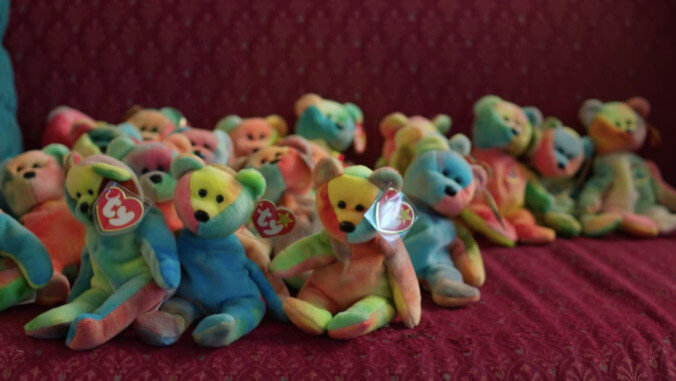HBO Max’s Beanie Mania is a fascinating retrospective on a ’90s toy obsession
The documentary revisits the collective mania that would only be rivaled by the release of the Harry Potter books

Two decades after the end of the toy phenomenon that swept the U.S., the HBO Max documentary Beanie Mania revisits the history of how Beanie Babies rose to prominence through a combination of archival news footage and colorful interviews with key players of the game. These players include former Ty Company employees, professional Beanie Baby resellers, and prominent collectors turned early influencers who helped take the brand from local fad to national obsession.
Beanie Mania weaves an entertaining, fast-paced narrative that reveals the depths to which collective fanaticism, greed, and the influence of the internet, even in its earliest days, all combined to create an inflection point that led to an unprecedented and unsustainable investment bubble. Visually, Beanie Mania makes the most of its subject, with playful interstitials of Beanie Baby toys intercut with plain text that move the narrative forward in time and introducing interviewees with title cards that feature Beanie Babies as stand-ins.
The source of the hype, the documentary reveals, all began in 1996 in the Chicago suburb of Naperville, not too far from the Ty, Inc. headquarters, where a group of affluent stay-at-home moms living in the same subdivision started collecting Beanie Babies for their children from local gift shops. Determined to complete their collections, the women quickly spiraled into an addiction that involved spreadsheets, phone bills of upwards of $2,000, and an encyclopedic familiarity with all available Beanie Baby inventory nationwide.
This proved to be a boon for the women, because company founder Ty Warner refused to do any advertising or media—as the earliest collectors, the Naperville group of mothers became the de facto mouthpieces for the toys and acted as early influencers, making appearances on local media to talk about the latest Beanie releases and building up hype which quickly expanded nationwide.
While Beanie Mania primarily focuses on the key players who profited from the beanie-filled craze, it does feature interviews with some collectors whose lives were heavily impacted by the toys, including Jeannine Marron Twardus, a former cryptological technician for the FBI turned gift shop owner whose passion for collecting the toys nearly bankrupted her. (Unfortunately, Frances and Harold Mountain, the divorced couple who famously had to split their Beanie Baby collection in the courtroom after failing to do so themselves, do not make an appearance.)
“The collector’s mentality is that you can never have enough… and that’s dangerous,” says Mary Beth Sobolewski, one of the mothers in the original Naperville group and founder of the popular Beanie Baby collector magazine Mary Beth’s Beanie World (which changed its name to Mary Beth’s Bean Bag World after Warner sued her for trademark infringement).
The exponential scale of growth is simply staggering; between 1996 and 1997, sales shot up 1,000% in a matter of months, with 500,000 beanies selling monthly. Sales reached close to $1.4 billion by 1998, followed by a McDonald’s Happy Meals “Teeny Beanie” partnership that sold out five weeks of product within two weeks. The archival news footage—which includes brief interviews with children and shopkeepers—effectively reestablishes both the nostalgia and the absurdity of the collective mania that would only later be rivaled by the release of the Harry Potter books.
Even more fascinating than the rapid ascent of Ty, Inc. itself is what Beanie Mania reveals about the unofficial secondary market universe that revolved around the toys, from collector guides to Beanie Baby jewelry sold at ersatz fan conventions, and the mania brought on by speculative collectors more interested in making a financial investment than actually collecting. By 1997, secondary market resellers would make an average of 500% profit on the retail price. The other prominent takeaway is the outsize influence the Naperville mothers continued to have in controlling the narrative of authenticity within the secondary market—for despite the success and hundreds of thousands of requests coming in from retailers at the height of the craze, and thousands of counterfeiters flooding the market with fakes, Warner continued to refuse to invest in any official Beanie Baby advertising or press. As one former collector notes, “There was no evidence that they would ever be worth anything. We all just believed it.”
Given Warner’s reticence, it is not surprising, though disappointing, that he himself is not included in the group of interviewees. Famously reclusive, his own lawyer states there is “absolutely zero” chance that the director will get an interview, and so, Beanie Mania fills in the details by asking the other interviewees about him. He’s described as a litigious Wizard of Oz/Willy Wonka figure who began his career committed to supporting smaller toy stores and welcoming each new employee, but who soon alienated the people closest to him and the success of the company through his own greed.
“It was a really nice thing for a while, until the adults ruined it,” reflects Joni Hirsch Blackman on the craze, as another member of the Naperville mothers’ group and a former journalist for People magazine who was the only person to ever interview Warner about Beanie Babies. Still, despite the inevitable decline of the largest toy craze of the 1990s, there are those, like Peggy Gallagher, who still enjoy collecting Beanies and have no regrets. When asked if she feels good about the whole experience and spending so much time and money, she responds, “I do. Because I love them.”